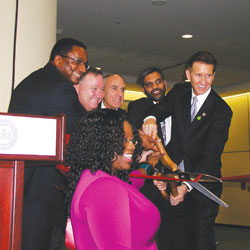
|
| The Greenbuild 2011 ribbon-cutting ceremony. In front: Kimberly Lewis, vice president, conferences and events, USGBC. Back, from left: Michael Thompson, Toronto city councilor; Michael McSweeney, president and CEO, Cement Association of Canada; Bob Peck, GSA; Mahesh Ramanujam, COO, USGBC; Mark MacCracken, chair, USGBC board of directors. |
TORONTO — The U.S. Green Building Council’s (USGBC) Greenbuild International Conference & Expo kicked off in Toronto with 23,000 delegates from around the world. The event showcased the latest in green building products, technologies, and innovations. It began with an opening plenary celebration at the Air Canada Centre.
“This is the first time Greenbuild has been held outside of the U.S., and Toronto is a fitting place to celebrate 10 years of Greenbuild,” said Rick Fedrizzi, president, CEO, and founding chair, USGBC.
Fedrizzi opened the event, welcoming the crowd to Greenbuild. Pulitzer Prize-winner Thomas Friedman talked about the necessity of a green revolution: “We’re not having a green revolution (right now); we’re having a green party. In revolutions, people get hurt — companies are forced to change or they die.” He added, “Our revolution will be here when the word green disappears.”
Friedman also spoke about the importance of price signals and long-term fixed consumer demand. He talked about loops that are shaping the future, including how the rising food prices lead to political instability which leads to oil crises, and so on. He spoke of a broader intersection of climate change, population growth, and globalization, taking a page from his book, Hot, Flat and Crowded 2.0. Friedman identified 1979 as a year that led to a path of consumption, pollution, and climate change, and pointed to the 2008 economic crisis as the wake-up call when both the market and Mother Nature crashed. Ending with a call to action, Friedman said, “The challenge we have today is that we must become the regeneration.”
Fedrizzi returned to the stage as the event turned to USGBC’s Resiliency Agenda. “The green building movement will jumpstart a fragile and struggling economy,” said Fedrizzi. “Resilience in Haiti is about rebuilding and education — harnessing a culture’s spirit.” ABC News political commentator Cokie Roberts moderated a panel featuring medical anthropologist Dr. Paul Farmer, former Canadian prime minister Kim Campbell, and Friedman on the topic of resilience. Farmer reflected on his work in Haiti before the 2010 earthquake and the rapidly mobilized global response in the time following the disaster. “The earthquake forced us to reconsider how we build infrastructure, and that’s a good thing,” said Farmer.
Campbell praised attendees’ work toward a greener built environment, noting, “This group understands that we have a challenge. Instead of being in denial about climate change, [they’re] looking for solutions.”
USGBC also introduced Project Haiti, its initiative in partnership with architectural firm HOK to build a LEED Platinum orphanage in Port-au-Prince. “If we can build a LEED Platinum building here in the poorest country in the Western hemisphere, we can build one anywhere,” said Roger Limoges, chief of staff, USGBC.
Fedrizzi ended his remarks with a look to the year 2037, envisioning the day when the USGBC closes its doors, having accomplished its seemingly unachievable mission. Imagining what USGBC would announce when that day comes, Fedrizzi said simply, “We changed the world.”
Chart-topping rock band Maroon 5 closed out the evening on a celebratory note with an energetic performance featuring hits like “Moves Like Jagger” and “Misery.”
A long-time champion for the environment, Maroon 5 went carbon neutral for its 2007 tour, performed at the Live Earth Inaugural Ball in 2009, and was honored at the 2006 Environmental Media Awards. The band has also taken the stage in support of Haiti, launching the Haiti: Aid Still Required campaign movement earlier this year, and played at A Night to Benefit Haiti in Los Angeles.
For more information, visit www.greenbuildexpo.org.
Publication date: 10/31/2011

Report Abusive Comment